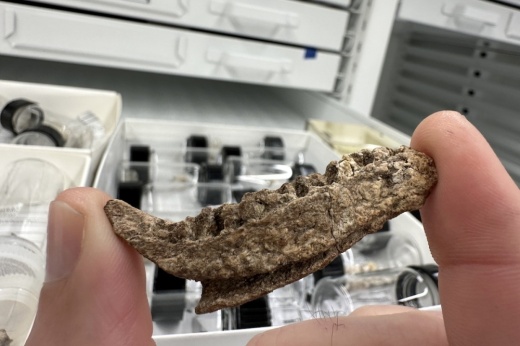The fossil named Ampelognathus coheni marks the fourth instance a dinosaur has been named from rocks in North Texas. The name Ampelognathus means “Grapevine jaw” and pays homage to the location of the find while the species name, coheni, honors the volunteer fossil hunter who made the find, Murray Cohen.
The overview
Cohen discovered the nearly 2-inch fossil for the dinosaur, which likely belonged to the animal’s lower left jawbone, in late 2019, said Ron Tykoski, vice president of science and curator of vertebrate paleontology at the Perot Museum. It is believed that Ampelognathus coheni was an herbivore, according to the news release.
“This needle-in-a-haystack find enhances what we know about prehistoric life in North Texas,” said Dori Contreras, curator of paleobotany at the Perot Museum. “This discovery helps us reconstruct the ecosystem along the ancient shoreline that cut across the region at the time.”
Initially, researchers tried to match up the discovery to other prehistoric life and crocodiles, but Tykoski said the find was not consistent with other discovered fossils in the area that included larger herbivores and armored dinosaurs.
“That caught our attention because the only other plant-eating dinosaurs were really large or little bits of armored dinosaurs,” Tykoski said. “This didn’t fit the anatomy of either of those.”
Dig deeper
Tykoski said the museum has permits with the Army Corps of Engineers to explore areas around Lake Grapevine that are not accessible to the public. Because of a small staff, the museum also relies on enthusiasts or everyday residents for a number of fossil discoveries.
“A lot of the finds here in North Texas come from folks like Murray [Cohen] who are enthusiastic about nature and fossils,” Tykoski said. “We have a page on our website where folks can upload photos of things they have found, and our staff will take a look at it and try to do an identification based on the photo.”
Additionally, the find of Ampelognathus coheni in the rocky areas surrounding Lake Grapevine is a contribution to a generally poor fossil record for prehistoric plant and animal life that existed in the Cretaceous Period nearly 96 million years ago, Tykoski said. When discoveries are made in the largely developed areas of North Texas, it is usually a new contribution to the fossil record, Tyskoki added.
Quote of note
“After spending a lot of time trying to make it match previously known animals, we realized that we might actually have something that is new here,” Tykoski said.
What else?
Ampelognathus coheni joins three other dinosaurs that were discovered in rock formations in the Dallas-Fort Worth area, per the news release.
- Pawpawsaurus, a dinosaur known for its armored plates
- Protohadros, a large, plant-eating dinosaur
- Flexomornis, a prehistoric bird





